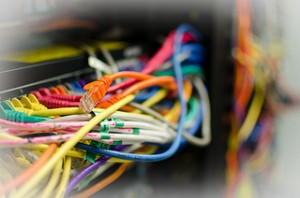 If you are not a computer expert, it might be tempting to hire an expensive computer professional to setup your office computer network. However, it is a lot easier that you might think. This guide will help you do it yourself.
If you are not a computer expert, it might be tempting to hire an expensive computer professional to setup your office computer network. However, it is a lot easier that you might think. This guide will help you do it yourself.
Table of Contents
Determine Your Needs
The first step in getting internet for your business is to determine your needs. Your local internet serviceprovider is one option, though there are better options for bigger offices that have bigger needs.
Most small businesses would do fine calling the local cable or phone company. If you need something bigger, check into more powerful business offerings from companies like Level 3 Communications, Cogent, and other business focused telecom carriers.
Get Internet Installed
Once you figure out your needs, call your new service provider and get setup. Depending on the type of internet and the carrier you choose, this can take anywhere from a couple of days to a couple of month.
High performance internet requires more infrastructure, so it can take longer to install than internet that moves across a cable or copper phone line.
Setup Your Modem and Router
Most likely, your ISP will include a modem with your setup. A modem is the device that converts the internet signal from the cable or wire into a signal your network can use. A router is a device that connects the devices in your office to the signal from the modem. In some cases, the modem androuter can be one device.
If you have only a few computers, a wireless router might be the easiest option. Wireless networks can be setup securely (use WPA-2 encryption for the easiest, safest option) but sacrifice speed for the convenience. In many cases, the speed difference is not noticeable.
If you are able, the best connections come through a wired network. Ethernet cables are used to connect to the wired router if you choose this route, so make sure you are able to get a hard wire into each desk and work area if you choose a wired network.
Many businesses choose both wired and wireless. Wired is used at the employee desks and wireless is used around the office. To setup your router, you may have to connect one computer. I used my laptop when I last had to setup a router because I could take it to the physical location therouter was going to be living.
If you choose a wired network and need to connect more devices than the router can plug in, you will have to buy a switch, which is a device that lets you plug in more devices to the router. A switch can be placed near the router or closer to the work stations, whichever makes more sense for your business.
Add Your Computers
Now that you have setup your router, it is time to connect your computers. If you choose the wireless route, that is as simple as turning on the wireless adapter on the device, choosing your network, and entering your password.
If you have a computer without a wireless NIC (network interface card), you will have to purchase and install one. Most modern computers come with a wireless NIC built in, but that is not always the case.
If you are going with a wired network, connect the Ethernet cable to the back of the router and run it to each computer. Some offices have built in Ethernet plugs in the wall that look like a big phone jack.
When you plug in your Ethernet cable to the router or switch, those computers will generally connect automatically.
Add Your Printers, Copiers, and Servers
If you are using a server or network attached storage (NAS) device, plug those into the router or switch as well. The same goes for any wired network printers, copiers, backups, media systems, and servers.
For wireless devices, you will have to setup the connection to your network through a built in interface, through a laptop, or looking up the device’s IP address on your network, something like 192.168.2.2. The device will have instructions to walk you through the process.
Depending on the device, they may require setup as well, but they should come with setupinstructions. Shared network printers and storage devices can be used by any device attached to the network.


Great tips there Eric.
To add to the discussion I think over the next few years VOIP / internet telephony will also come in to play here. Hopefully it will be as simple as plugging another box in to the network, a few headsets in to the computer (or phone handsets in to the LAN), and a minor bit of software setup to make it all work.
If you have reliable internet, VOIP is fantastic for saving money and eliminating another piece of office equipment (the digital PBX) that some professionals charge a lot of money to service even the most basic of requests, such as reassigning an extension.